How To Install Dryer Vent On Vinyl Siding
Dryer Vents: How to Claw Upwards and Install Dryer Vents
How to install a rigid metallic duct for a safer dryer.
![]() Time
Time
A total mean solar day
![]() Complexity
Complexity
Intermediate
![]() Toll
Toll
$51–100
Introduction
To speed up clothes drying and prevent lint build-up, install a smooth metal dryer vent. These footstep-by-pace directions walk you through the tough parts. Rigid metal vents are safer than flexible plastic and metallic types, which catch more lint, require more cleaning and can retard airflow. Even worse, flexible ducts are hands crushed, which blocks airflow and causes the dryer to overheat, which in turn tin can lead to lint fires. In this story, nosotros'll show you how to cut and install 4-inch rigid metal duct, including the toughest part—drilling the leave hole through an exterior wall.
Tools Required
Materials Required
- 4-in. duct
- 4-in. elbows
- Duct cap
- Exterior caulk
- Foil tape
- Piping straps
- Vent cap
Video: How to Install and Upgrade Your Dryer Vent
Projection stride-by-step (14)
Pace one
Cull the Shortest Route for the Vent
ane. From an Underground Basement
- If your dryer is in the basement and the basement is hugger-mugger, run duct up the exterior wall and out the rim joist.
- Prepare the vent a minimum of 12 inches above the outside ground.
- Pro tip: Use no more than 25 anxiety. of 4-inch duct, and subtract 5 feet for every 90-degree turn and ii 1/2 anxiety for every 45-degree turn for dryer vent installation. For case, a dryer with a xc-degree elbow at the frazzle port and another at the top of the basement wall can run a maximum of xv feet.
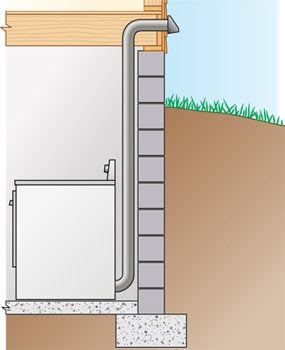
two. Straight Path From the Basement
- If the dryer is against an exterior wall that is not secret, run the duct straight out from the back of the dryer.
- Set the vent a minimum of 12 inches above the outside ground.
- Note: This is the simplest, nearly ideal solution. The shorter the distance and fewer the turns the better for dryer vent installation.
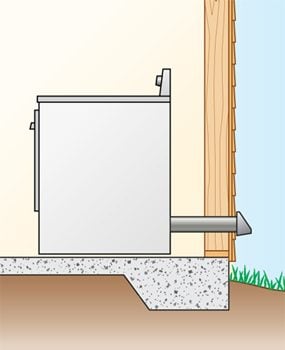
iii. Through the Attic to the Roof
- If the dryer is an interior room of the house, vent through the attic to the roof.
- Annotation: Vent a dryer through the roof only as a last resort. Cleaning lint buildup from roof vents is difficult, and nesting birds and squirrels often find roof vent caps irresistible.
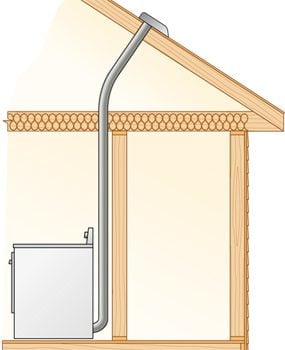
Step 2
Get Shopping
- In one case y'all've decided on a vent location and planned the dryer duct route, measure the length of the run, allowing for bends.
- Buy enough directly duct and fittings to complete the job, including an outdoor cap.
- Pro tip: Use either galvanized steel (our choice) or aluminum duct, but don't mix parts.
Step 3
Drill a Test Hole in the Rim Joist
- Marking the center of the rim joist and drill a examination hole with a 1/4-inch chip.
- Locate the hole outside and bank check for obstructions.
- Pro tip: If the hole is a piffling low or the cap doesn't sit in the all-time position on the siding, it'south not too belatedly to adjust it. If it's really wrong, you can easily make full the hole and beginning over at a unlike location.
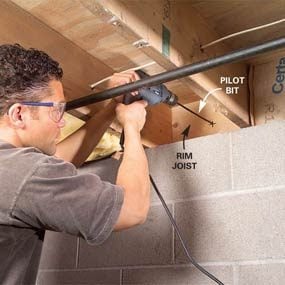
Step 4
Adjust the Pigsty to Fit the Siding
- Shift the pigsty and then the elevation of the vent cap rests on the high indicate of the lap siding.
- Pull the vent cap and duct apart to make measuring easier.
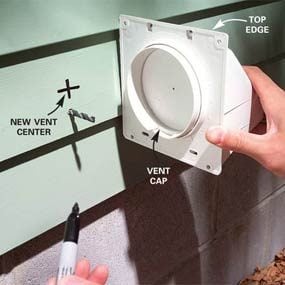
Step 5
Drill the Vent Hole in the Siding
- Diameter a 4-ane/iv inch hole with a pigsty saw.
- Pro tip: Hold the drill level and steady. Pull the drill back often to clear the sawdust and permit the drill motor cool.
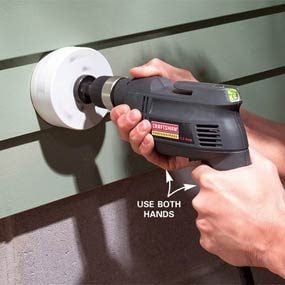
Footstep 6
Drill Through the Rim Joist
- Finish and pry out siding and capsule from the saw equally you get.
- Keep your cut through the rim joist.
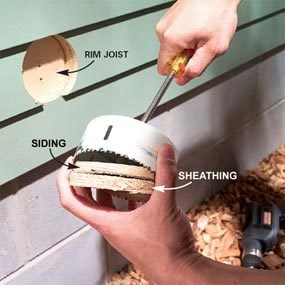
Step vii
Install the Vent Cap
- Insert the vent and screw the cap to the business firm (predrill screw holes).
- Push foam capitalist rod into deep gaps.
- Caulk all effectually with acrylic caulk.

How to Mountain a Vent Cap on Vinyl Siding
There are 2 skilful ways to install dryer vents through vinyl siding. The first is to install a vinyl surface mounting block (shown here) that fits over the existing siding. You may demand to scribe and trim the edges to precisely fit your siding profile. Fasten the surface mounting cake to the house with screws, but remember to drill slightly oversize holes through the vinyl to allow for siding movement.
The 2d method is to remove a section of siding and install a special vinyl mounting block (not shown) against the sheathing. Cut the siding to fit effectually information technology. Both are available from vinyl siding dealers.
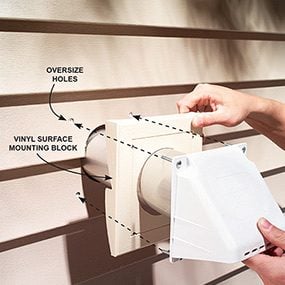
How to Make the Vent Hole in Stucco and Brick Veneer
Getting through stucco and brick requires different techniques and tools than for wood and vinyl. You'll need a masonry chip with a hammer drill for your pilot hole. Then trace a 4-1/2 in. circle and drill a series of closely-spaced holes around the circumference with the 1/4-in. masonry flake and hammer drill. Break out the masonry with a cold chisel. Snip the wire mesh back if yous're chipping out stucco. Then drill through the forest sheathing and framing with a iv-1/4 in. hole saw.
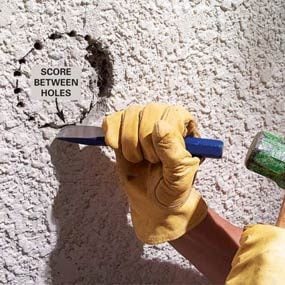
Pace 8
Cut the Vent to Length
- Cutting the direct sections to length with tin snips before you snap the seams together.
- Pro tip: Vesture leather gloves—the cut metallic edges are sharp.
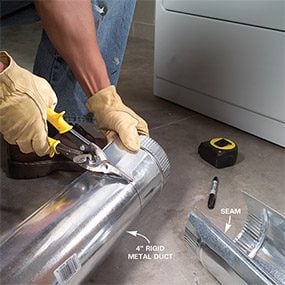
Step 9
Shut the Seam on the Vent
- Align the seam edges of the duct.
- Working from i end, push the edges down slightly as yous force them together.
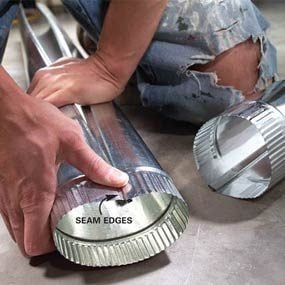
Pace 10
Record the Elbow Joints
- Start at the dryer and insert the crimped terminate of the first elbow into the first straight section.
- Tape the joints with metal foil tape.
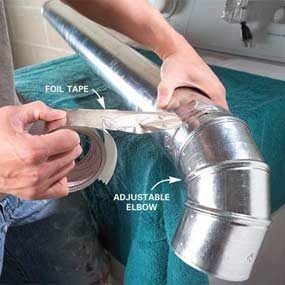
Step 11
Attach the First Vent Section
- Slide the first fitting onto the dryer and button the dryer confronting the wall.
- Mensurate, cut and assemble the other duct sections.
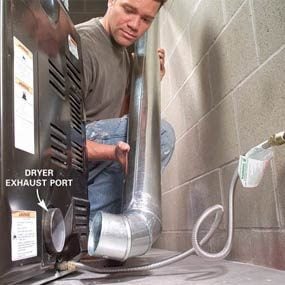
Step 12
Install the Remaining Vent Sections
- Slide the last elbow onto the direct section coming upwards the wall.
- Push the crimped cease of the elbow into the duct cap department and tape it.
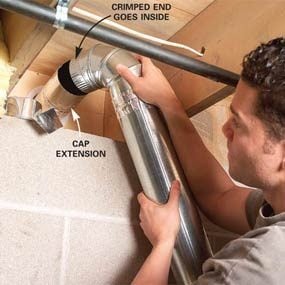
Footstep 13
Secure the Vent to the Wall with Straps
- Ballast the duct to walls or ceilings every 6 to viii anxiety with a pipe strap.
- Pro tip: Loop the strap around the duct; don't screw the strap to it.
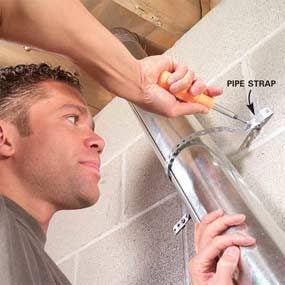
Step xiv
Turn on the Dryer
- Plug the dryer in and turn information technology on.
- Check outside to make certain the vent flap is opening.
A Note on Cleaning
Lint buildup reduces dryer efficiency, which means apparel have longer to dry. Check the vent cap frequently and brush out lint. At least once a year, snake a vacuum hose into the dryer duct to clean it. Tapping on the dryer duct while y'all do this will help knock off lint that'southward stuck to the sides and joints. To avoid fires, vacuum lint from effectually dryer drums, burners and motors at the bottom of the chiffonier.
Source: https://www.familyhandyman.com/project/how-to-install-a-dryer-vent/
Posted by: trevinopopop1971.blogspot.com

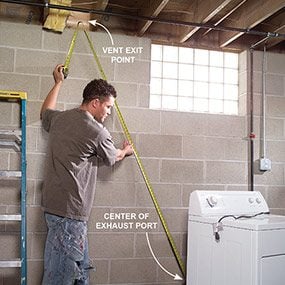

0 Response to "How To Install Dryer Vent On Vinyl Siding"
Post a Comment